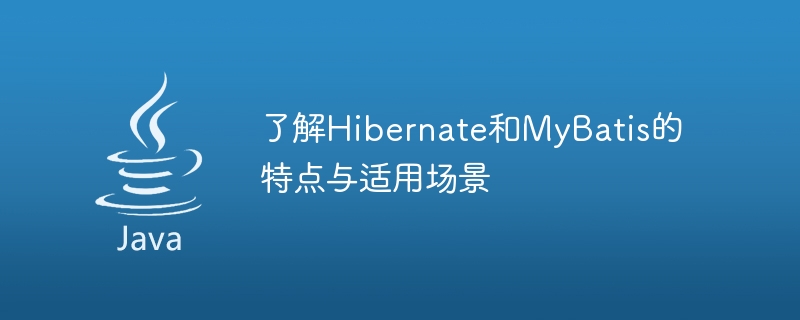 Java
Java
 javaTutorial
javaTutorial
 Compare Hibernate and MyBatis: Understand their characteristics and applicable scenarios
Compare Hibernate and MyBatis: Understand their characteristics and applicable scenarios
Compare Hibernate and MyBatis: Understand their characteristics and applicable scenarios

Understand the characteristics and applicable scenarios of Hibernate and MyBatis
With the development of the Internet and the advent of the big data era, the use of databases has become more and more common and important . For Java developers, Hibernate and MyBatis are two commonly used persistence frameworks. This article will introduce the characteristics and applicable scenarios of Hibernate and MyBatis to help readers understand and choose the appropriate framework.
First, let us understand Hibernate. Hibernate is an open source ORM (Object Relational Mapping) framework that can map Java objects to tables in the database, simplifying the database access process. Hibernate has the following characteristics:
- High degree of automation: Hibernate can reduce the workload of manually writing SQL to a great extent by automatically mapping Java objects and database tables. Developers only need to focus on the implementation of business logic and do not need to care about specific SQL statements.
- Cross-database support: Hibernate has good cross-database support and can run on different databases without modifying the code. This is useful for projects that require switching between multiple databases.
- Cache management: Hibernate provides support for first-level cache and second-level cache, which can improve database performance. The first-level cache is a session-level cache that can reduce the number of database queries. The second-level cache is an application-level cache that can share data between multiple sessions and reduce the load on the database.
Although Hibernate is a very powerful persistence framework, it is not suitable for all projects. In the following scenarios, using MyBatis may be more appropriate:
- Need to manually optimize SQL: In some projects with high performance requirements, manual tuning of SQL may be required. MyBatis supports directly writing native SQL statements, which can control the execution of SQL more flexibly.
- The database platform is not unified: If the project requires the use of multiple database platforms and involves complex cross-database operations, then MyBatis may be more suitable. MyBatis's SQL statements can be flexibly changed according to different databases.
- Involving complex business logic: For projects that require complex business logic operations, MyBatis provides greater flexibility. Developers can write complex SQL queries to meet specific needs.
In summary, Hibernate is suitable for projects that have relatively simple database access and require a high degree of automation, while MyBatis is suitable for projects that have special needs for database access, require manual optimization of SQL, or involve more complex projects. Business logic project.
In summary, it is very important for Java developers to understand the characteristics and applicable scenarios of Hibernate and MyBatis. Choosing an appropriate persistence framework based on the needs of the project and the actual situation can not only improve development efficiency, but also optimize database performance. I hope this article can help readers better understand Hibernate and MyBatis and be able to make wise choices in actual projects.
The above is the detailed content of Compare Hibernate and MyBatis: Understand their characteristics and applicable scenarios. For more information, please follow other related articles on the PHP Chinese website!

Hot AI Tools

Undresser.AI Undress
AI-powered app for creating realistic nude photos

AI Clothes Remover
Online AI tool for removing clothes from photos.

Undress AI Tool
Undress images for free

Clothoff.io
AI clothes remover

AI Hentai Generator
Generate AI Hentai for free.

Hot Article

Hot Tools

Notepad++7.3.1
Easy-to-use and free code editor

SublimeText3 Chinese version
Chinese version, very easy to use

Zend Studio 13.0.1
Powerful PHP integrated development environment

Dreamweaver CS6
Visual web development tools

SublimeText3 Mac version
God-level code editing software (SublimeText3)

Hot Topics
 1377
1377
 52
52
 How does Java's classloading mechanism work, including different classloaders and their delegation models?
Mar 17, 2025 pm 05:35 PM
How does Java's classloading mechanism work, including different classloaders and their delegation models?
Mar 17, 2025 pm 05:35 PM
Java's classloading involves loading, linking, and initializing classes using a hierarchical system with Bootstrap, Extension, and Application classloaders. The parent delegation model ensures core classes are loaded first, affecting custom class loa
 How do I implement multi-level caching in Java applications using libraries like Caffeine or Guava Cache?
Mar 17, 2025 pm 05:44 PM
How do I implement multi-level caching in Java applications using libraries like Caffeine or Guava Cache?
Mar 17, 2025 pm 05:44 PM
The article discusses implementing multi-level caching in Java using Caffeine and Guava Cache to enhance application performance. It covers setup, integration, and performance benefits, along with configuration and eviction policy management best pra
 How can I use JPA (Java Persistence API) for object-relational mapping with advanced features like caching and lazy loading?
Mar 17, 2025 pm 05:43 PM
How can I use JPA (Java Persistence API) for object-relational mapping with advanced features like caching and lazy loading?
Mar 17, 2025 pm 05:43 PM
The article discusses using JPA for object-relational mapping with advanced features like caching and lazy loading. It covers setup, entity mapping, and best practices for optimizing performance while highlighting potential pitfalls.[159 characters]
 How do I use Maven or Gradle for advanced Java project management, build automation, and dependency resolution?
Mar 17, 2025 pm 05:46 PM
How do I use Maven or Gradle for advanced Java project management, build automation, and dependency resolution?
Mar 17, 2025 pm 05:46 PM
The article discusses using Maven and Gradle for Java project management, build automation, and dependency resolution, comparing their approaches and optimization strategies.
 How do I create and use custom Java libraries (JAR files) with proper versioning and dependency management?
Mar 17, 2025 pm 05:45 PM
How do I create and use custom Java libraries (JAR files) with proper versioning and dependency management?
Mar 17, 2025 pm 05:45 PM
The article discusses creating and using custom Java libraries (JAR files) with proper versioning and dependency management, using tools like Maven and Gradle.



